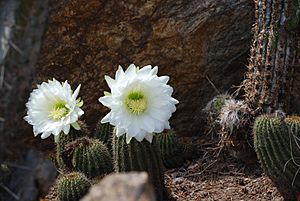Soehrensia schickendantzii facts for kids
Quick facts for kids Soehrensia schickendantzii |
|
|---|---|
 |
|
| Conservation status | |
| Scientific classification | |
| Genus: |
Soehrensia
|
| Species: |
schickendantzii
|
| Synonyms | |
|
|
Soehrensia schickendantzii is a type of cactus found in northwestern Argentina. It grows in the provinces of Salta and Tucumán. This cactus lives in high places, from about 1600 to 3200 meters (about 5,200 to 10,500 feet) above sea level.
What Does It Look Like?
Soehrensia schickendantzii often grows like a small bush. Sometimes, it grows alone, but usually, it forms groups by branching out from its base. Its stems are shaped like cylinders or are a bit longer and thinner. They are a shiny light green color.
These stems can be 15 to 25 centimeters (about 6 to 10 inches) long. They can also be up to 6 centimeters (about 2.4 inches) wide. The cactus has 14 to 18 low ridges, called ribs, which are a bit sharp and have small notches.
On these ribs, there are special spots called areoles. These areoles are very close together, sometimes even touching. Yellowish thorns grow from these areoles. They are flexible and can be up to 1 centimeter (about 0.4 inches) long. Each areole usually has four main thorns in the center. As the cactus gets older, it might grow more central thorns. There are also nine thorns around the edges of each areole.
Flowers and Fruits
The flowers of this cactus are white and do not have a smell. They are shaped like a tube or a funnel. These flowers grow near the top of the cactus stem and open up at night. They are quite long, about 20 to 22 inches (50 to 56 centimeters). The part of the flower that forms the tube is covered in dense black hairs.
After the flowers, the cactus grows round, dark green fruits. These fruits are sweet and split open when they are ripe. They can be up to 6 centimeters (about 2.4 inches) long and 5 centimeters (about 2 inches) wide.
How It Got Its Name
This plant was first described by a scientist named Frédéric Albert Constantin Weber in 1896. He first named it Echinopsis schickendantzii. Later, in 2012, another scientist named Schlumpb. renamed it Soehrensia schickendantzii. This new name was published in a scientific paper called Cactaceae Syst. Init.
The name schickendantzii was chosen to honor a German chemist named Friedrich Schickendantz (1837–1896). He moved to Argentina in 1861.
See also
 In Spanish: Echinopsis schickendantzii para niños
In Spanish: Echinopsis schickendantzii para niños


